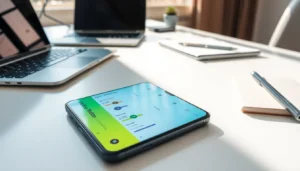In a world where smartphones have become our trusty sidekicks, it’s easy to lose track of just how much time we spend glued to those glowing screens. If you’ve ever wondered whether your phone is your best friend or just a time-sucking black hole, checking your screen time on a Samsung device could be the eye-opener you need. Spoiler alert: it might just reveal that your Netflix binge-watching has become an Olympic sport!
Samsung makes it simple to keep tabs on your screen time, ensuring you stay in control of your digital habits. Whether you’re aiming to reclaim your time or just curious about your usage, this guide will walk you through the steps to uncover the truth. So grab your phone and get ready to face the screen time music—because knowledge is power, and who doesn’t want to be the master of their own device?
Table of Contents
ToggleUnderstanding Screen Time
Screen time refers to the duration spent on devices such as smartphones, tablets, and computers. Evaluating screen time is essential for understanding digital habits and their impact on well-being. Samsung devices offer built-in features to help users track their usage effectively.
Tracking screen time provides insights into which apps consume most time. Users can categorize their activities, identifying patterns that may indicate excessive use of specific applications. Notifications from Samsung devices can remind users to take breaks, promoting physical and mental health.
Screen time insights also allow for goal setting. Users can limit time spent on certain apps or set daily benchmarks. This feature supports healthier digital habits, offering control over device interaction.
Samsung’s Digital Wellbeing feature collects data on daily activity, showing total screen time for each application. Accessing this feature requires navigating through the settings menu. Once found, users can view detailed reports breaking down usage by day or week.
Comparing weekly stats aids in recognizing trends over time. Changes in behavior may occur after identifying high usage periods or specific apps. Increased awareness often leads to positive adjustments in mobile habits.
Customization options enhance the screen time experience. Users can tailor their monitoring preferences, adjusting settings based on personal goals. Privacy remains a priority; Samsung ensures that users control who sees their data.
Understanding screen time fosters mindfulness in today’s smartphone-driven world. Engaging with this information empowers users to make informed choices about device usage. It encourages a balanced lifestyle, sparking thoughtful discussions about technology’s role in daily life.
How To Check Your Screen Time On Samsung
Checking screen time on Samsung devices helps users understand their usage patterns and improve digital habits. Follow these methods to easily monitor your screen time.
Using Settings
Accessing screen time through Settings offers a straightforward approach. Navigate to the Settings app, and select Device Care. Tap on Battery, and then click on App Usage. Here, users can view the time spent on each application, giving insight into digital habits. This feature allows individuals to prioritize app usage based on their preferences and lifestyle.
Using Digital Wellbeing
Digital Wellbeing enables a comprehensive view of screen time on Samsung devices. Open the Digital Wellbeing app, found within Settings. Users can see an overview of daily usage, including time spent on apps and notifications received. Setting timers for individual applications promotes healthier usage, fostering a better balance between screen time and offline activities. This feature encourages users to be mindful and make informed choices about their device interactions.
Benefits Of Monitoring Screen Time
Monitoring screen time offers several significant benefits for users. Users gain insight into their device usage patterns, which helps in identifying potential overuse. Improved awareness leads to informed decision-making regarding digital habits.
Individuals can set goals to reduce screen time, promoting healthier lifestyles. Adjusting usage based on insights can enhance productivity and focus. Awareness of time spent on various applications encourages more meaningful engagement.
Families benefit from tracking screen time, facilitating healthier electronic habits for children. Parents can supervise digital interactions, ensuring a balanced approach to technology. Through monitoring, they reinforce limits and promote outdoor activities.
Mental well-being improves when individuals consciously manage screen time. Reducing excessive exposure to screens may lead to better sleep quality. Users often find that it alleviates anxiety associated with constant connectivity.
Additionally, screen time monitoring fosters digital mindfulness. Individuals consciously engage with technology instead of mindlessly scrolling. This intentional usage promotes a more rewarding digital experience.
Healthier relationships with technology emerge as users prioritize offline activities. By balancing screen time, they connect more with friends and family. Enjoying shared moments away from devices enhances overall life satisfaction.
Ultimately, monitoring screen time supports users in cultivating a more balanced digital lifestyle. Investing time in self-reflection and adjustment boosts overall well-being.
Tips For Managing Screen Time
Monitoring screen time effectively involves implementing practical strategies. Users should start by setting specific goals for device usage. Establishing a daily limit can help maintain balance between online and offline activities.
Creating designated tech-free zones promotes more face-to-face interaction. Prioritize activities such as reading or exercising during breaks from screen time. Engaging in hobbies outside of digital devices fosters well-rounded life experiences.
Scheduling regular breaks while using devices enhances focus and reduces eye strain. Encourage consistent breaks every hour to improve overall well-being. Limiting notifications also minimizes distractions, allowing users to concentrate on important tasks.
Utilizing apps designed to track and limit usage offers additional support. Many tools provide visualizations of screen time, making it easier to identify patterns over time. Reviewing these insights can empower users to adjust their habits accordingly.
Involving family members in screen time discussions strengthens accountability. Parents can set collective goals, promoting healthier digital habits for everyone. Open conversations about screen time can foster understanding and encourage mindful usage among all family members.
Lastly, practice self-reflection to evaluate feelings around device usage. It’s crucial to consider whether screen time enhances or detracts from daily life. Adjusting habits based on these reflections can lead to healthier interactions with technology.
These tips contribute to a more mindful and balanced digital lifestyle. Users can embrace technology while prioritizing their well-being. Making small adjustments fosters a healthier relationship with devices over time.
Monitoring screen time on Samsung devices is essential for achieving a balanced digital lifestyle. By utilizing built-in features like the Digital Wellbeing app users can gain valuable insights into their usage patterns. This awareness not only helps in making informed decisions but also fosters healthier habits.
With the ability to set goals and track app usage users can create a more mindful approach to technology. Encouraging family discussions about screen time further promotes accountability and positive changes. Ultimately taking control of screen time leads to improved mental well-being and a more satisfying life beyond the screen. Embracing these practices can significantly enhance one’s overall quality of life.

